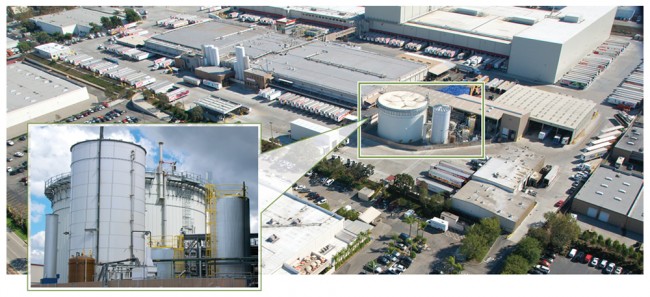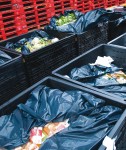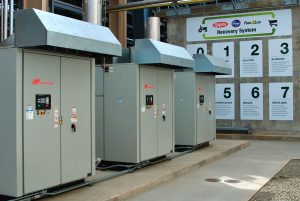The Ralphs/Food4Less distribution center in Compton, California showcases its 150 tons/day anaerobic digester.
Nora Goldstein
BioCycle June 2013, Vol. 54, No. 6, p. 41
In mid-May, The Kroger Co. drew back the curtain on a 150 tons/day anaerobic digestion system at its 59-acre Ralphs/Food4Less distribution center in Compton, California. The system started operating about a year earlier, but the parties involved wanted to be sure everything was running smoothly before its unveiling. The “Kroger Recovery System” is processing food waste from over 350 Ralphs and Food4Less grocery stores in all of southern California, and additional stores elsewhere in California and Nevada. “We began operating the digester about a year ago, and have increased throughput slowly and smartly and are now fully operational,” says Kendra Doyel, Vice-President of Public Relations at Ralphs.

The Kroger Recovery System includes an anaerobic digester with a 2-million gallon reactor tank and a 250,000-gallon staging tank for incoming material. The installation at the food distribution center highlights the integration of AD of food waste into an urban environment.

Food waste, including some meats and bones, is collected from Ralphs and Food4Less stores. Depackaging takes place as part of the AD system.
Digester System
The system was designed, installed and is currently operated by Feed Resource Recovery (FEED) based in Boston, Massachusetts. The company was founded in 2007 to manage food waste from the food retail and service sectors more efficiently. “Our initial focus was on smaller scale behind-the-store type systems,” explains Ryan Begin of FEED. “We built a pilot unit but soon recognized it would be more efficient to take advantage of economies of scale by building much larger systems. Essentially, in an application like Ralphs/Food4Less, we would have been installing units at over 350 individual stores, which would all have to be equipped and serviced. It became obvious that building larger plants to service a company like Kroger made much more sense, both financially, logistically and environmentally.”
FEED approached Kroger Co. about three years ago with the idea for the project, recalls Doyel. “They knew we were already diverting our food waste and brought their technology to us to consider. We went through the process of learning more, including the payback on our investment, and decided to move forward. The Kroger Recovery System is fully owned and staffed by Kroger.”
Neither Begin nor Doyel would provide many details about the actual system, which has a 2 million gallon reactor tank, and a 250,000-gallon staging tank for incoming material. A video prepared as part of the grand opening shows the basic components of the wet digestion system (see link on web version of this article). The grocery stores are not required to depackage any of the food waste. Therefore the first step is to load all food waste into a depackaging-type process, where nonorganic materials are removed and the feedstock is size reduced. Wastewater from the creamery is pumped into the staging tank.
Biogas is captured from the top of the reactor tank and fed to a gas conditioning unit to remove moisture and compress the gas. The facility has several Ingersoll Rand microturbines, which offset more than 20 percent of the energy demand of the distribution center. Heat is captured from the microturbines for the digester process. Conditioned biogas is also used in the boilers at the creamery. Digested solids are taken off site for composting.

The facility has several Ingersoll Rand microturbines, which offset more than 20 percent of the energy demand of the distribution center.
When the technology was being designed, Begin and his partner, Nick Whitman, conducted food waste audits at grocery stores to provide statistically representative data for the company’s software to model. The installation at the Ralphs/Food4Less distribution center is FEED’s first commercial scale project, and highlights the feasibility of integrating anaerobic digestion of food waste into an urban environment. Kroger is interested in installing similar systems at some of its other locations around the country. “We are still vetting it,” notes Doyel. “The Recovery System has only been operational at full-scale for a short period of time. We are very pleased with the performance to date.”










